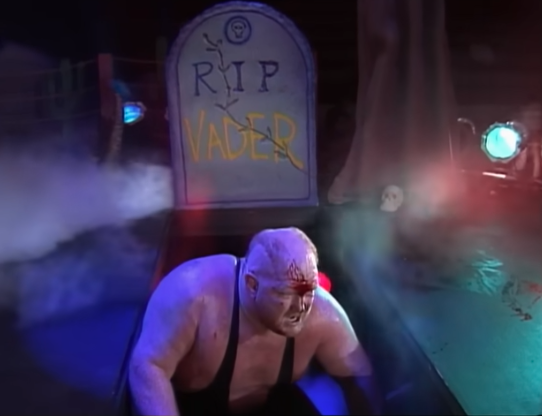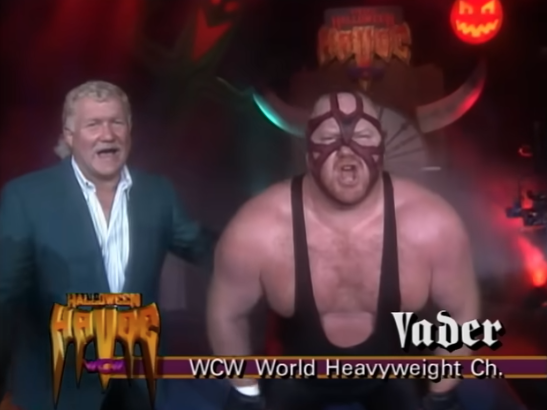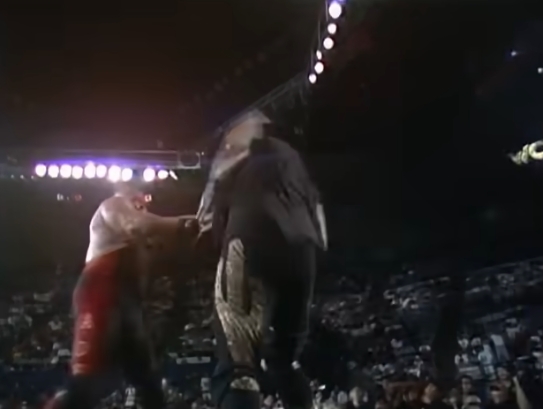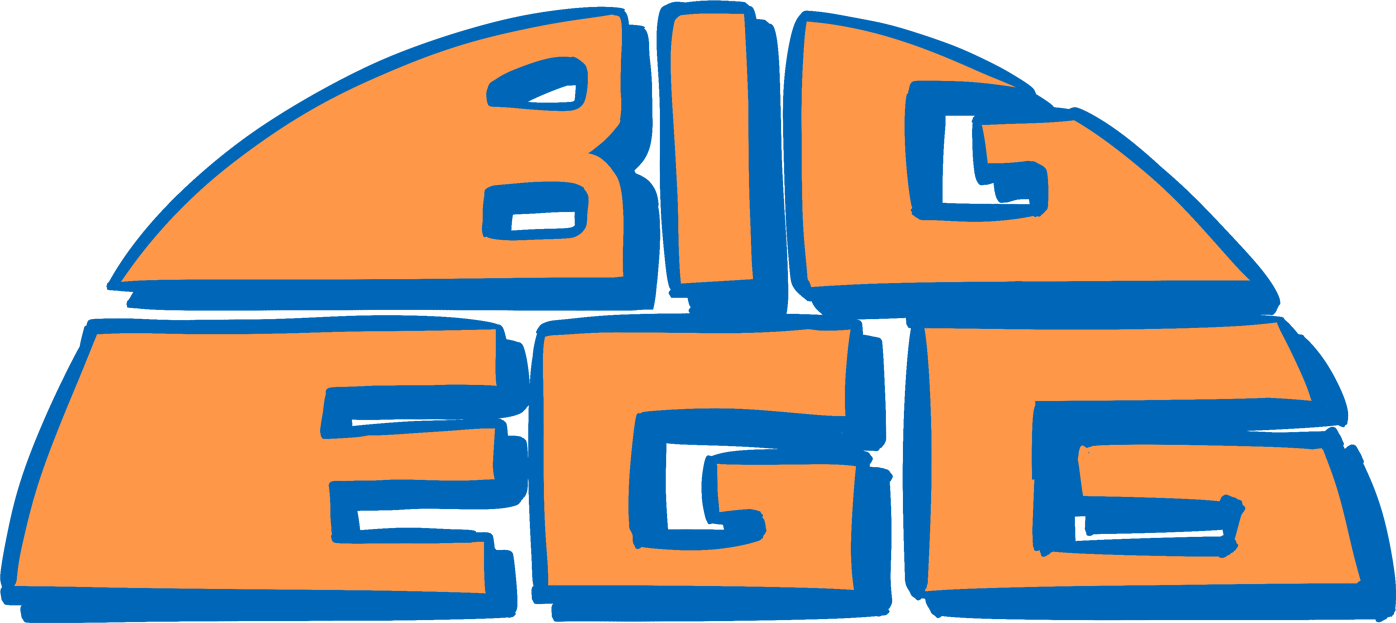Cactus Jack and Vader Almost Save Halloween From WCW
Cactus Jack and Big Van Vader look to settle the score at Halloween Havoc 1993, but WCW had other plans.

I don’t think WCW ever understood what they had with Mick Foley. I know that’s the common line on Foley’s time in Atlanta, that this is, indeed, the line on many wrestlers who worked there before becoming centerpieces of the World Wrestling Federation’s Attitude Era, but five years before he revitalized the moribund Mankind character by becoming one of wrestling’s most sympathetic babyfaces, he established that odds-defying template in World Championship Wrestling.
Cactus Jack debuted in WCW in 1989, working his way up the ranks from featured jobber to featured performer to trusted hand to legitimate star by 1992, part of an exciting crop of young wrestlers that included Steve Austin, Sting, Brian Pillman, and Dustin Rhodes. He, like most of that cohort, was still developing as a complete package, but he was closer to fully-realized than most — a gifted brawler, a psychotic bumper, and an unsettling promo whose loudQUIETloud speaking style and uncanny eye for the camera (still and moving alike) still feel revolutionary decades later. In 1992, he wrestled Sting in a Falls Count Anywhere match at Beach Blast, the best match on one of WCW’s best ever shows, a match both Foley and Sting cite as one of the best of his career. Great or not, there is a limit to the number of top heels a promotion can support, and it’s much more difficult to break through to the true upper echelons of wrestling as a heel than it seems. In 1992, WCW had Rick Rude, flanked by the Dangerous Alliance, who slotted in when Lex Luger left for the WBF. It had Jake Roberts for a time, though that experiment failed. It had “Japanese wrestling” as a concept, mostly for the Steiner Brothers. And, of course, it had Big Van Vader.

Vader was, as you know, managed by Harley Race, who needed a substitute for an injured “Ravishing” Rick Rude and set up a street fight between Cactus Jack and Paul Orndorff for the slot, hanging out at ringside to tell both men how best to mangle the other. Jack and Orndorff’s matches are underrated, Orndorff a low-key jock psychopath and Foley absolutely at his best getting hammered by this type of wrestler. Race is an incredible pest once this goes to the outside, gruffly hollering at each man to prove themselves to him. Jack wants in the match, but he’s not what you call “management material” — he gets tired of Race, hits him with a clothesline off the apron, and that brings out Vader. Orndorff joins the team, Jack helps his one-time rivals in Rhodes and Sting at the Clash, and suddenly you have a babyface Jack and an obvious rival in the dominant WCW Champion.
If you’re willing to ignore the Lost In Cleveland stuff around it, Jack/Vader is one of the best feuds of 1993. The TV matches are stiff and brutal, infamous for what Foley was willing to put himself through, whether it be powerbombs on concrete or stiff punches to the eye, and it worked. Cactus Jack was a contender for the WCW Championship, a sympathetic babyface despite his size and his look, and Halloween Havoc 1993 was his reward: a singles main event on PPV.
The thing is, I’ve never liked this one as much as some of their TV matches. Their Saturday Night diptych is particularly incredible — one of the few truly great moral victories in wrestling when Jack wins by count out followed by Vader’s brutal revenge when he powerbombs Jack on the floor of Center Stage. The finish of this Texas Death Match is comparatively limp, a means of sending Jack back to the tag division where a returning Ric Flair wouldn’t have to think as hard about what to do with him when he eventually became the booker.
Spin the Wheel, Make the Deal is one of WCW’s more infamous gimmicks because the wheel wasn’t weighted to favor a style of match anybody wanted to see when they debuted it for Sting vs. Jake Roberts, which wound up being a Coal Miner’s Glove on a Pole match. “Texas Death” sounds much more appetizing, but in WCW that means that to win, you have to pin your opponent, who then has to stand before a 10 count. Between the fall and the 10 count? A 30-second rest period.

The rest period has always been my issue with this match. A three count or a 10 count are fine, you’re not asking for much time between the move that clinches the match and the release of the bell, but to string those things together and add 30 seconds in-between? That’s 43 seconds. In wrestling, that is an eternity for nothing to happen. But in the same way that I’m ignoring Lost In Cleveland to praise the angle as a whole, I am going to try to forget the rules until they rear their ugly head.
Vader has his fair share of definitional moments as the monster heel in WCW, when his world crashes down around him at the hands of a white hot babyface. The opening moments of this match is one of them, as he’s completely overwhelmed by Cactus Jack. While Schiavone recounts the ridiculousness of everything that happened between the April powerbomb and now, Jack unloads with righteous fury on the champion, using chairs, guardrails, and a fan’s camera to lay his ass out while the crowd begs for more. Vader has never looked more terrifying than when he takes over on Jack in the ring, punching angrily at his face and opening it up in an early callback to their first Saturday Night match. Jack fires back with multiple suplexes on the ramp. This is a fight, pure and simple, and as both men roll into a grave that reads “RIP VADER,” there’s a clear argument to be made for this as one of the best WCW matches, which only gets better when Vader emerges from his own grave, bleeding, and gets clotheslined by Cactus for the first fall of the match.

Then, goddamn it, the rest period. Of course Vader gets up early enough into the actual 10 count for it to not be so annoying, then he gets hit by a cactus, a cactus elbow, and gets pinned again.
So like, look — Cactus Jack has now pinned the WCW World Heavyweight Champion twice, but since “falls don’t count” there is no bell, and since there is no video screen for the fans to see the stuff that happens outside of the ring, there is no pop for the pins. Gary Michael Capetta does a good job of speeding things along during the rest period, but there’s no drama to the 10 count because you can’t see or hear it. But then, goddamn, Vader explodes on Jack in anger, Jack fires back, they get a table into the ring, and we’re back in business, Vader taking table bumps like he learned how by watching Sandman tapes from the near future. When this is moving, it’s incredible. There’s a spot where Jack tries to rush at Vader with a forearm while Vader’s in the front row, and Vader pulls the guardrail back so Jack flies over it at top speed, that’s absolutely bonkers. He follows this by back body dropping Cactus over the rail, where he seems to land on his head.

Race produces the all-time WCW death weapon, the cattle prod, but chooses not to use it as Vader hits a moonsault. Three count. Rest period. Jack is already on his knees by the time it ends and is up by three on the 10 count. After that, Vader hits Jack with the all-time murder combo of a full-weight drop onto the ramp, a home run swing with a chair, and a DDT on the chair. Vader shoos away the training staff, gets the pin, and then Jack is up and fighting before the rest period ends. Both men are down after a Cactus Jack DDT, Race hits Jack with the cattle prod, Vader gets to his feet, and that’s that.

Oy, man. There is so much to love here, but beyond the way in which the match is overburdened by its rules, the finish is an overwrought mess, an attempt at putting over Jack’s toughness and giving him a moral victory (he DDTs Race after the match) when an actual one is what’s called for. A physical triumph undercut at every turn by technical failure or outright cowardice — it's little wonder Mick Foley was looking for the exit within a year.
Rating: *** & 1/2
